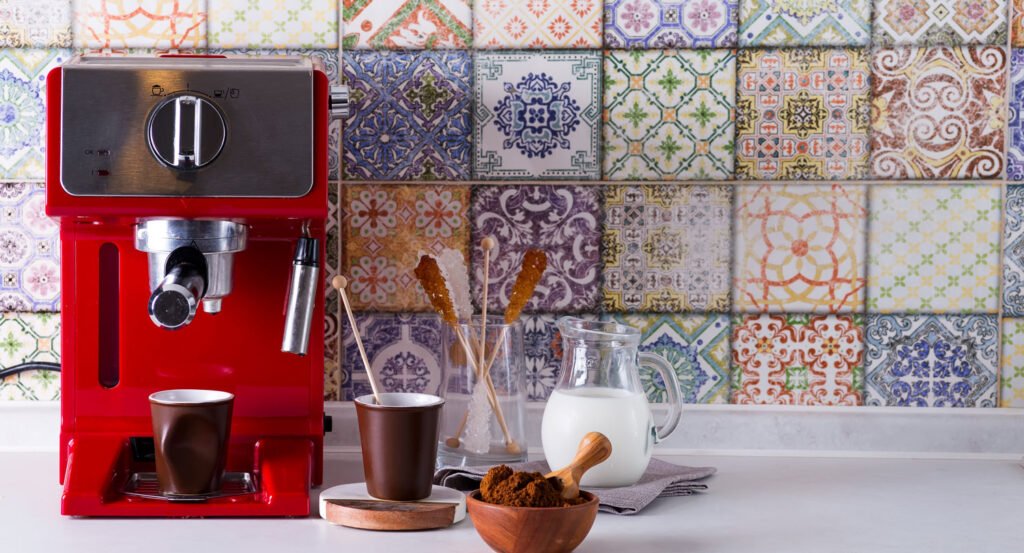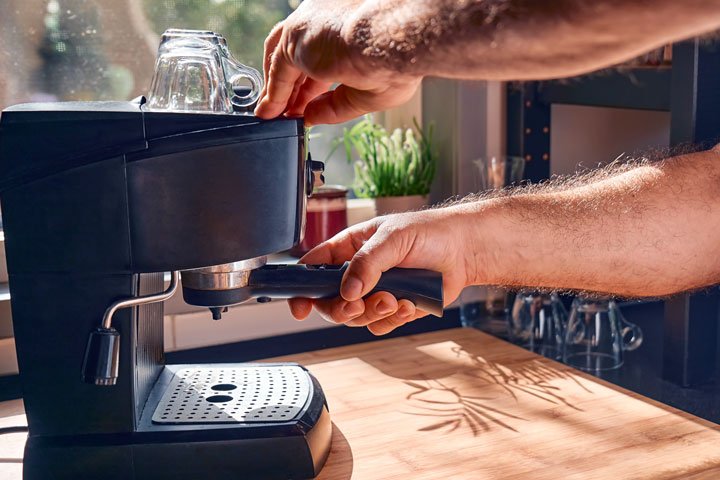Imagine the delight of waking up to the aroma of freshly brewed espresso right in your own kitchen, delightfully defined as the pinnacle of coffee brewing by coffee enthusiasts worldwide. Not only can home espresso machines save you time and money compared to frequenting local coffee shops, but they also offer the satisfaction of perfecting your barista skills and tailoring your drink to fit your personal taste.
This guide will show you how to brew like a pro, equipping you with knowledge starting from how to choose the right espresso machine, to operating it for best results, and even tips on maintaining and cleaning your machine.
So, whether you’re a novice or a coffee aficionado seeking to enhance your brewing technique, this beginner’s guide embraces the fascinating world of home espresso machines. Let’s dive in and set you on the path to serving your own excellent, home-crafted espresso.
Getting Started: Choosing the Right Machine
Embarking on your home espresso brewing journey begins with selecting the ideal machine. Here are some factors to consider in selection and how they may impact the quality of your homemade espresso:
Factor 1: Size
Size is an essential element when purchasing an espresso machine – you need a machine that fits comfortably in your kitchen. Espresso machines vary in size from small, compact models perfect for smaller kitchens, to larger, more industrial designs which require significant counter space. Alongside considering the dimensions of the coffee machine, understand that some require clearance space above for filling water tanks or adding coffee beans.
Factor 2: Budget
Espresso machines come in a wide price range, from relatively inexpensive to high end. Your budget will help guide this decision, but remember that generally, the pricier machines have more features and brewing capabilities, provide more control over espresso extraction, and tend to last longer. The trick is to find a balance between cost and functionality that suits your needs.
Factor 3: Features
You should also consider the features different home espresso machines have to offer. Some include integrated coffee grinders, programmable settings, water filters, milk frothers, double boilers, and even cup warmers. These additional features may increase the price, so think about the importance of these extras and whether they would add value to your coffee brewing experience.

Understanding the Types of Machines
Once you’ve considered the size, budget and features, it’s time to delve into the types of machines. These generally fall into two categories: manual and automatic.
1. Manual Machines: This type of machine offers a hands-on experience and more control, enabling you to brew espresso just right according to your preference. With a manual machine, you dictate water temperature, pressure, and extraction time, which can be challenging for beginners, but rewarding once mastered. Manual machines are also usually more durable due to their mechanical nature, although they typically come with a steeper price tag and learning curve.
2. Automatic Machines: These are excellent for beginners since they automate much of the brewing process. They control the water temperature and pressure, and often offer a one-touch brewing option. More advanced models even grind the coffee beans, tamp the grounds, and froth the milk for you. Although they lack the level of control that manual machines offer, automatic machines provide consistency and convenience, making them an excellent option for espresso novices.
Where to Buy an Espresso Machine
Purchasing an espresso machine is an investment. Luckily, they are readily available on many online platforms like Amazon, eBay, and specialized sites like Seattle Coffee Gear and Whole Latte Love. These online retailers offer a broad range of options, reviews to influence decision making, and competitive prices. Alternatively, purchasing from a physical store gives you the chance to see the home espresso machines firsthand, gauge its size accurately, and get personalized advice. Whether online or in-store, ensure to buy from a trusted retailer to secure a warranty and after-sale services.
Now that you’re geared with basic knowledge about choosing the right espresso machine, remember that the ultimate goal is to find a machine that fits your needs and allows you to enjoy the espresso brewing process. The perfect machine for you could be a robust manual model requiring careful attention or an automatic version providing convenience and consistency. It’s all about what meets your desires and fits your lifestyle, making your journey into the world of home espresso brewing a truly enjoyable one.
Operating Your Espresso Machine for the Best Results
Once you’ve picked the perfect machine, it’s time to master the art of espresso brewing. Even though the process might seem overwhelming at first, with practice you’ll soon be crafting espresso that rivals your favorite coffee shop.
Prepping your Ingredients
Preparation begins with sourcing quality ingredients. You’ll need fresh coffee beans – preferably specialty grade – and pure filtered water. The type of roast depends on your personal taste, but generally, a medium to dark roast is typically used for espresso. Invest in a quality grinder if your machine doesn’t have one built-in, as freshly ground beans are key to a great cup of espresso. To steam and froth, choose whole milk for its creamy texture and natural sweetness, although dairy alternatives also work.
Step-by-step instructions on using the machine correctly
Turn on and Preheat: Start your machine to allow it adequate time to preheat – around 15 to 20 minutes. A well-heated machine ensures the best flavor extraction and maintains an appropriate serving temperature.
Grind the Beans and Tamp: Measure the correct amount of coffee beans (typically 18-20 grams for a double shot), grind them just before brewing to maintain freshness, and adjust your grinder to a fine setting. Pour the finely ground coffee into your machine’s portafilter using a coffee doser to maintain consistency. Then, use a tamper to press down firmly on the grounds – you’re aiming to create an even, compact coffee bed.

Pulling Shots: Attach the filled portafilter to the machine, place your cup under the spout and then start the extraction process. This is where the hot, pressurized water passes through the compacted coffee grounds. For a double shot, aim to dispense around 60 milliliters of espresso within 20-30 seconds. Good espresso has a thick, golden crema on top.
Steaming Milk: After pulling your shots, move to the milk. Pour cold milk into a stainless-steel pitcher, not exceeding the halfway mark. Place the steam wand tip just under the milk surface and steam to create micro-foam. You’re aiming for a temperature of about 150°F. Frothing the milk transforms its flavor, sweetness, and texture, turning it creamy and smooth.
Making Specialty Drinks: To make a certain specialty drink, like a cappuccino or latte, pull the shot of espresso first as this is the base, followed by steaming and frothing the milk. For a latte, add more milk and less foam to your espresso, whereas a cappuccino requires equal parts of espresso, steamed milk, and milk foam.
With the process seeming complex on the surface, mastering the brewing steps uniquely blends science and art. Grasping each step’s purpose, particularly the impact of different variables – grind size, tamping pressure, water temperature, and shot timing – helps you brew consistent, delicious espresso. Remember, brewing espresso is as much about the journey as the destination. Learning to manipulate variables, and understanding how each affects the coffee quality is what makes home brewing rewarding and fun.
Much like coffee itself, preferences for preparation methods and techniques can vary drastically from one person to the next. Each machine comes with its own set of instructions and learning curve. Depending on whether you choose a semi-automatic, automatic, or manual machine, your tasks as the home barista will vary. No matter your machine, investing the time to understand your appliance, its features, and the unique aspects of its operation will undoubtedly lead to a superior espresso experience.
Cleaning & Maintenance Tips
Maintaining home espresso machines is crucial for its longevity and the quality of coffee it produces. Integrating cleaning routines into your coffee-making practices ensures delicious espresso every time and optimizes the performance of your machine.
Daily Cleaning Routine
Cleaning your espresso machine should be a regular activity, ideally after each use. First, make sure to knock out the coffee grounds from the portafilter and rinse it under hot water to remove the residual coffee oils. Also, clean the group head by running water through it without the portafilter attached. Don’t overlook the steam wand; immediately after use, wipe it with a damp cloth to remove milk residue and purge it to clear any milk trapped inside.
Descaling Process
When water is heated in your espresso machine, it leaves behind mineral deposits known as ‘scale.’ Over time, these deposits build up and can cause functional problems, such as clogging the water lines, manipulating water temperature, or even causing the machine to break down prematurely. Descaling involves using a specific descaling solution to break down these deposits, running it through the machine’s system, and then thoroughly rinsing it out. The requirement for descaling varies based on the machine and water hardness, typically ranging from once a month to once a year.
Beyond these routines, it’s advisable to schedule a thorough cleaning every few weeks. This deep cleaning involves disassembling the machine to clean the group head and portafilter, and soaking them along with the machine’s baskets in a specialized cleaning solution before rinsing and reassembling.
Adopting these maintenance practices will keep your espresso machine running effectively and prolong its life, allowing you to enjoy top-tier espresso right in the comfort of your own home for years to come.
The Last Drop
Embarking on the espresso brewing journey at home is a rewarding experience which allows you to delve into the realm of coffee and refine your skills as a barista. From the careful selection of your espresso machine to the fine-tuning of brewing techniques and maintenance rituals, each step brings you closer to savoring your own perfect cup of espresso. So, explore, experiment, and above all – enjoy the process.

Remember, the world of espresso is as rich as the drink itself, and your coffee journey has only just begun.
Happy brewing!








